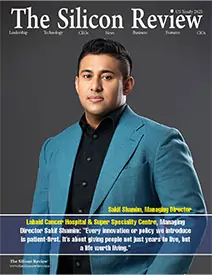Super 30 Companies of the Year 2024 Asia
Cognitive Liberation: Synchron’s Audacious Quest to Rewire Human Autonomy
The Silicon Review
![]()
In the ever-evolving realm of neurotechnology, few companies are as bold or boundary-defying as Synchron. This New York-based startup has captured global attention for its revolutionary brain-computer interface (BCI) technology—a minimally-invasive neural implant that allows individuals to control digital devices using only their thoughts. This isn’t science fiction. It’s the near future, powered by a company rooted in clinical pragmatism and profound empathy. At the center of Synchron’s groundbreaking platform is its endovascular BCI, a technology that marries neural engineering with interventional medicine. Its flagship device, the Stentrode™, bypasses the need for open brain surgery by being implanted through the blood vessels—akin to how a cardiac stent is placed. The vision is elegantly ambitious: to restore communication, control, and independence to people who have lost mobility due to conditions such as ALS, spinal cord injury, or brainstem stroke. For those suffering from paralysis, the gap between thought and action becomes a chasm. Synchron aims to bridge that chasm not with scalpels, but with sophisticated engineering, AI integration, and a network of clinical professionals already trained in endovascular procedures. It is not only reimagining the BCI field; it is rewriting the rulebook entirely.
An Elegant Bypass: Inside the Technology
Unlike traditional BCIs that require invasive brain surgery and bulky external hardware, Synchron leverages the vascular system—an already-charted roadmap—to reach the brain’s motor cortex. At the heart of this system is the Stentrode, an electrode-laced implant that senses brain signals from within a vein. Implanted using techniques familiar to interventional cardiologists, the Stentrode circumvents the risks and limitations of craniotomy-based systems. Complementing the Stentrode is a small internal receiver-transmitter (the IRT), which communicates wirelessly with the SPU (Synchron Processing Unit)—a sleek external device that decodes neural activity and transmits it to a smartphone or tablet. Through this setup, users are able to navigate apps, send messages, and operate smart home devices—all using pure intention. This convergence of neural signals, real-time AI computing (via partnerships with NVIDIA), and extended reality (through Apple Vision Pro) makes Synchron's ecosystem not only clinically viable, but life-changing. In one moving demonstration, a patient named Rodney uses Synchron’s system to feed his dog with his mind—an act so simple yet so monumental in the context of paralysis.
Building a Scalable Future: Functional Neurointervention
Synchron is not just advancing a product; it is establishing a new medical discipline: Functional Neurointervention. This emerging field aims to deliver neuroelectronics throughout the brain without open surgery, dramatically expanding the clinical footprint of BCI access worldwide. By designing its systems to be implanted by existing interventional physicians—a global workforce tens of thousands strong—Synchron unlocks a tenfold scalability advantage over its competitors. Moreover, Synchron’s technology is designed to deliver actionable brain data at scale. By being first to market with endovascular BCI, the company is poised to set a new standard in neural data accessibility, paving the way for innovations in brain mapping, monitoring, and even future therapeutic stimulation. It’s not just about movement—it’s about meaning, connection, and autonomy. The company’s mantra, “Empowering Autonomy and Social Connection,” reflects its broader mission to not merely restore function, but to revive the spirit of human agency itself.
A Decade of Relentless Innovation
Synchron was founded in 2012 by interventional neurologist and neuroscientist Dr. Tom Oxley, who saw the immense potential in combining neurophysiology with endovascular access. Over the past decade, the company has transformed from an ambitious concept into a clinically operational reality. The Synchron BCI has already entered human trials, with its U.S. clinical study (COMMAND) receiving FDA approval under the Investigational Device Exemption (IDE). This milestone made Synchron the first company to receive such clearance for an endovascular BCI device, placing it ahead of competitors in both safety and regulatory timelines. The leadership team—comprised of global experts in neuroscience, engineering, and regulatory science—is committed to scaling this vision responsibly. Synchron’s approach is deliberately measured yet intensely focused, balancing medical rigor with tech-enabled ambition. As regulatory and ethical conversations around BCI continue to mature, Synchron positions itself not just as a technology company, but as a steward of a future in which humanity and machine merge with purpose.
Looking Ahead: A New Gold Standard in Human-Machine Fusion
Over the next decade, Synchron aims to expand its neurotechnology platform beyond communication. The foundational architecture—recording and decoding motor signals from within blood vessels—opens the door to applications in mental health monitoring, neurodegenerative disease tracking, and therapeutic brain stimulation. What sets Synchron apart, however, is its insistence on integrating into people’s lives without turning them into cyborg prototypes. The system is discreet, intuitive, and fundamentally human-centered. Whether enabling someone to schedule a medical appointment, text a friend, or simply pet their dog, Synchron isn’t chasing the future. It’s quietly building it—one neural signal at a time. In a tech landscape crowded with noise, Synchron stands out by offering signal—literally and figuratively. Through its minimally-invasive brain-computer interface, it invites us to consider a world where mobility limitations no longer dictate one's ability to connect, to create, or to control.
Tom Oxley, CEO and Founder


 (1)_2025-10-21_13-35-14.webp)

_2025-10-02_10-21-48.webp)

